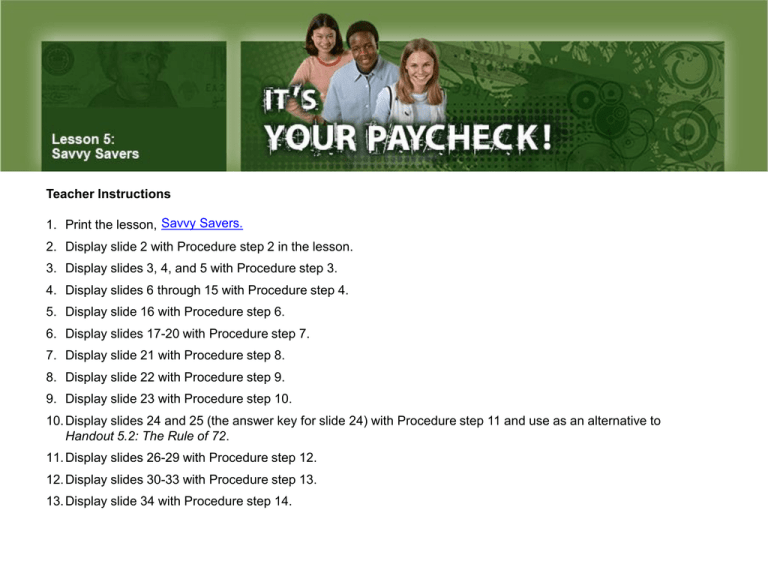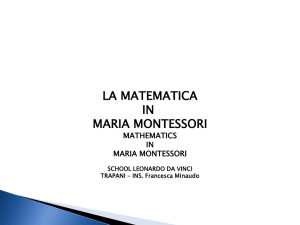Whiteboard
advertisement

Teacher Instructions 1. Print the lesson, Savvy Savers. 2. Display slide 2 with Procedure step 2 in the lesson. 3. Display slides 3, 4, and 5 with Procedure step 3. 4. Display slides 6 through 15 with Procedure step 4. 5. Display slide 16 with Procedure step 6. 6. Display slides 17-20 with Procedure step 7. 7. Display slide 21 with Procedure step 8. 8. Display slide 22 with Procedure step 9. 9. Display slide 23 with Procedure step 10. 10. Display slides 24 and 25 (the answer key for slide 24) with Procedure step 11 and use as an alternative to Handout 5.2: The Rule of 72. 11. Display slides 26-29 with Procedure step 12. 12. Display slides 30-33 with Procedure step 13. 13. Display slide 34 with Procedure step 14. Saving – Not spending on current consumption or taxes. Non-interest-bearing account – An account in which no interest is paid on the principal; also called a zero-interest account. Principal – The original amount of money deposited or invested, excluding any interest. Interest – The price of using someone else's money. Compound interest – Interest computed on the sum of the original principal and accrued (accumulated or earned) interest. Maria's Savings Decision Principal = $1,000 Interest rate = 5% paid semiannually (every 6 months) Step 1: Convert the annual interest rate to a decimal: 5% percent = 0.05 Maria's Savings Decision Principal = $1,000 Interest rate = 5% paid semiannually (every 6 months) Step 2: Divide the annual interest rate (as a decimal) by 2 to determine the interest paid every 6 months: 0.05 ÷ 2 = 0.025 Maria's Savings Decision Principal = $1,000 Interest rate = 5% paid semiannually (every 6 months) Step 3: Multiply the principal by the interest rate to get the interest paid in dollars. Round to the nearest hundredth. At 6 months: $1,000.00 × 0.025 = $25.00 Maria's Savings Decision Principal = $1,000 Interest rate = 5% paid semiannually (every 6 months) Step 4: Add the principal and interest to get the new amount of principal. At 6 months: $1,000.00 + $25.00 = $1,025 Maria's Savings Decision Principal = $1,000 Interest rate = 5% paid semiannually (every 6 months) Step 5: Repeat steps 2 and 3 to calculate interest and principal for each 6-month time period. Maria's Savings Decision Principal = $1,000 Interest rate = 5% paid semiannually (every 6 months) Step 3: Multiply the principal by the interest rate to get the interest paid in dollars. Round to the nearest hundredth. At 12 months: $1,025.00 × 0.025 = $25.63 Maria's Savings Decision Principal = $1,000 Interest rate = 5% paid semiannually (every 6 months) Step 4: Add the principal and interest to get the new amount of principal. At 12 months: $1,025.00 + $25.63 = $1,050.63 Interest Compounded Semiannually 2. Fill in the chart for Maria's two savings options. 3. Maria lost $_______ by keeping her money in a non-interest-bearing account rather than putting it in an account that paid a 5% interest rate compounded semiannually. 4. What could Maria have bought with the $50.63 of interest she might have earned on her savings? Would Maria classify as a saver or a savvy saver? Why? Saver. She didn't invest her money in a way that would give her a return on her investment—that is, an account that would pay her interest on her principal. Why might Maria have kept her $1,000 in a non-interest-bearing account? Possibilities: She was financially lazy—not proactive. She may not understand the importance of compound interest. Imagine that instead of $1,000, Maria's grandmother had given her $10,000. After three years, how much interest would $10,000 earn at a 5% interest rate compounded semiannually? $1,596.93 Why is time—that is, the number of months you have your money in an interestbearing account—a very important factor in accumulating savings? The sooner you start saving, the sooner you start earning interest—not only on your principal but also on accrued interest. Your money works for you over time. How long would it take for Maria's $1,000 to double if she kept the money in a non-interest-bearing account? It would never double. How long do you think it will take Maria's $1,000 to double if she puts the money in a savings account that pays compound interest? The rule of 72 – A method to estimate the number of years it will take for a financial investment (or debt) to double in value at a given annual interest rate. 72 ÷ 5 = 14.4 The Rule of 72 The Rule of 72—Answer Key Does the amount of interest an account pays have much of an impact on how long it will take for your money to double? Yes. The higher the interest rate, the less time it will take for your money to double. The risk-reward relationship – The idea that there is a direct relationship between risk of the loss of principal and the expected rate of return. The higher the risk of loss of principal for an investment, the greater the potential reward. Conversely, the lower the risk of loss of principal for an investment, the lower the potential reward. What annual interest rates do credit cards charge? Interest rates on credit cards vary over time and under different financial conditions in the economy, but generally credit cards charge relatively high interest rates. If a credit card charges an 18% annual interest rate, approximately how long will it take for your debt to double if you make no payment on the debt? 4 years; 72 ÷ 18 = 4 Review What is a non-interest-bearing account? A non-interest-bearing account is one that pays zero interest on principal. What is interest? Interest is the price of using someone else's money. Review What is compound interest? Compound interest is interest computed on the original principal and accrued interest. Review What interest rate would a savings account or a low-risk investment likely pay—would it be a low, medium, or high interest rate—and why? They would each pay a low interest rate because of the risk-reward relationship. Review What does the rule of 72 estimate? The rule of 72 estimates the number of years it will take for a financial investment—or debt—to double in value at a given interest rate. Handout 5.3: Charlie's Financial Goal—Answer Key








